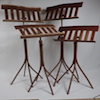This is a long story but I’ll try to make it short.
So so I was given some trees that were cut by a family member and because they were located in the Minneapolis area they were able to get a guy to cut the trees into boards. I told them to just slab cut the trees at about 2¬” thick. Most of it was an what we think is oak. As large as the trees were it¬’s probably a native species to that area of Minnesota.
In exchange anger for the wood I’m making them a table. This wood has sat stacked for 2 1/2 years.
Being that the way the wood was cut I decided to make the top first and see how it worked first. A few splits or a slight warping won’t matter as it’s the top. I then would make a trestle base out of either more of the oak or metal. It’s 40” by 72”.
I brought the the wood into my shop and let it acclimate for 2 weeks before working it. Setting my meter to white oak wood denestity showed it was around 9% moisture.
Here¬’s the problem: there is an extreme amount of tension in the wood. It checks massively when I cut the ends off. This scrap was an off cut from the top and I four square milled.
The the next day these checks developed.
The he top has warped massively as well 3/8 over 40”. I took an even amount of wood off both faces for a total of 3/8”. 2” to 1 5/8”.
Some checks moved by a 1/4 overnight then stopped. Some of the wood split at the glue line as well.
Anybody have any thoughts on why the wood has so much tension? All the off cuts when cutting go wild either pinching or opening up. Even cross grain cuts.
Ignoring the checks could I just force this top flat with a metal base? Obviously the bolt holes would be slotted allowing it to move just not up and down.
I thought I wasn’t reading the wood moister right so I figured the density and it puts it in the exotic hardwood range. It is so dense a hammer rings on it like striking steel. With this setting the moisture shows 6%. Any suggestions? Will they even be a good epoxy river pour candidates?





 Reply With Quote
Reply With Quote


